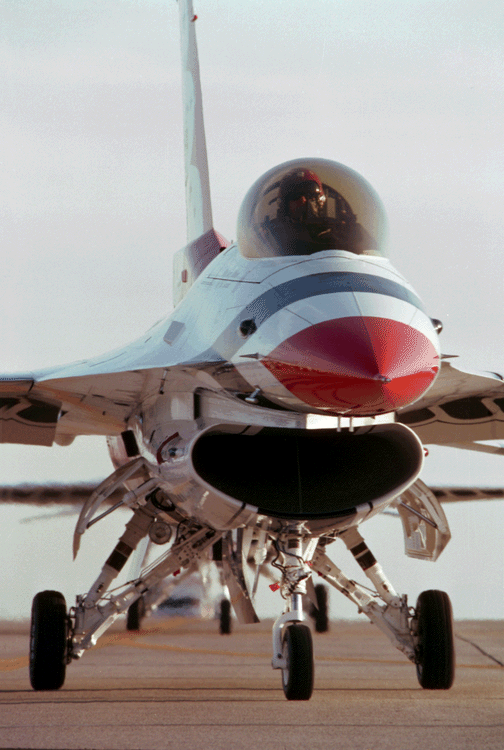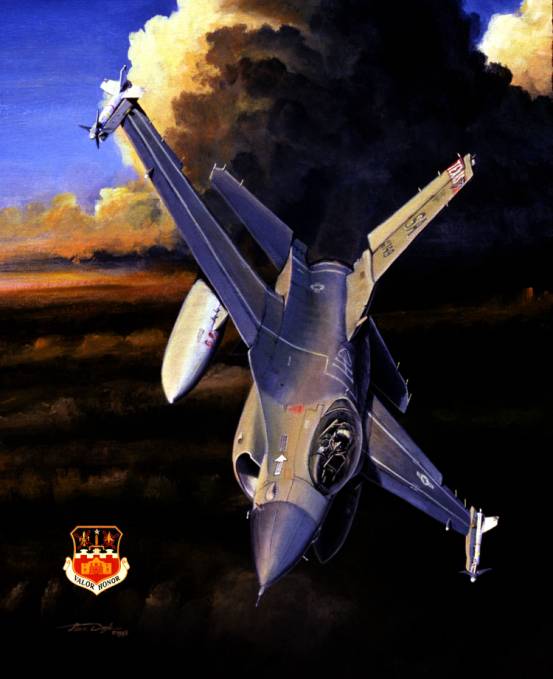
Boeing is teamed with Lockheed
Martin, Pratt & Whitney and the U.S. Air Force to develop the F-22 Raptor as a
replacement for the F-15.
The fast, agile, stealthy F-22 will take over the air superiority role with Air
Combat Command starting in 2005. The Air Force plans to procure 339 F-22s, and
production is scheduled to run through 2013.

Mission
The F-22's primary mission is to establish absolute control of the skies over
any battlefield — a must-have in modern warfare. It provides first-look,
first-shot, first-kill capability. The F-22 is an air superiority fighter with
much improved capability over current Air Force aircraft. Its stealth,
supercruise ability, integrated avionics and other features will make it the
most potent fighter in the world.

Current
Activity
A $9.55 billion contract for F-22 Engineering and Manufacturing Development, or
EMD, was awarded to the team in August 1991. Contract changes since then
have elevated the contract value to approximately $15 billion. Under the terms
of the contract, the F-22 team is completing the design of the aircraft and
avionics, building production tooling, and manufacturing and testing nine
flight-test and two ground-test aircraft.
In December
1998, the U.S. Air Force exercised a firm fixed-price contract option with
the Lockheed Martin/Boeing contractor team totaling approximately $189 million
for advance procurement of six Low Rate Initial Production aircraft.
The production
option was exercised less than a week after the Air Force exercised firm
fixed-price contract options totaling approximately $503 million for two F-22
production representative test vehicle aircraft and associated program support
for calendar year 1999.
In December
1999, the F-22 team was awarded contracts totaling more than $1.5 billion to
build six additional production representative test vehicle. Aircraft deliveries
are scheduled to begin in November 2001 and continue through December 2002.

Raptor
Unveiled, Flight Testing Begins
The first F-22 built under the EMD contract was unveiled in a ceremony on April 9, 1997,
in Marietta, Ga. First flight took place on Sept. 7, 1997, and in
May 1998, Raptor 01 made its formal entry into flight test. The newest
F-22, Raptor 03, made its first flight in March 2000 with Boeing pilot
Chuck Killberg at the controls.
Significant
flight milestones that have been met include surpassing the Congressionally
mandated 183 flight-test hours, supersonic flight, in-flight refueling, weapon
release and completing ground-vibration tests and angle-of-attack tests.
As of April 2000,
F-22 pilots at the Combined Test Force, Edwards Air Force
Base, Calif., have logged 618 hours and 272 flights in the program's
three test F-22s.

Avionics
Integration
Boeing, responsible for integrating the Raptor's advanced avionics, has been
testing software "blocks" in both its avionics integration lab, or
AIL, since 1998, and on its 757 Flying Test Bed, or FTB, since March 1999. Both
the AIL and FTB are helping reduce avionics risks and development costs by
enabling extensive evaluation and troubleshooting before full avionics are ever
installed on the F-22.
As of April 2000,
Boeing has completed more than 15,000 hours of avionics testing in the AIL and
430 hours on the FTB. Boeing delivered the first avionics flight-test package,
Block 1.1, to Lockheed Martin ahead of schedule in May 1999. Boeing now is
testing an early version of Block 3.0 software on the FTB.

F-22 Team
The F-22 teaming arrangement has allowed unprecedented industry cost-sharing and
taken advantage of the different companies' strengths in advanced technology,
production capability and systems integration.
Prior to its
selection as winner of what was then known as the Advanced Tactical Fighter
competition, the F-22 team conducted a 54-month demonstration/validation
program. The effort involved the design, construction and flight testing of two
YF-22 prototype aircraft. Two prototype engines, the Pratt & Whitney YF119
and General Electric YF120, also were developed and tested during the program.
The demonstration/validation program was completed in December 1990.
Much of that
work was performed by Boeing in Seattle, Wash.; Lockheed (now Lockheed Martin)
in Burbank, Calif.; and General Dynamics (now Lockheed Martin) in Fort Worth,
Texas. The prototypes were assembled in Lockheed's Palmdale, Calif., facility
and made their maiden flights from there. Since that time Lockheed's program
management and aircraft assembly operations have moved to Marietta, Ga.,
for the EMD and production phases.
Division of
Work
Boeing in Seattle, Wash., is responsible for the wings, aft fuselage
(including the structures necessary for engine and nozzle installation),
avionics integration, 70 percent of mission software, the training system,
flight-test development and management, and the training, life-support and
fire-protection systems.
Lockheed Martin
Aeronautical Systems, a division of Lockheed Martin Corporation, based in
Marietta, Ga., is responsible for program management, the integrated
forebody (nose section) and forward fuselage (including the cockpit and inlets),
leading edges of the wings, the fins and stabilators, flaps, ailerons, landing
gear and final assembly of the aircraft.
Lockheed Martin
Tactical Aircraft Systems, based in Fort Worth, Texas, is responsible for the
center fuselage; stores management; integrated navigation and electronic warfare
systems; the communications, navigation, and identification system; and the
weapon support system.

The F-16 Fighting Falcon is a compact, multirole fighter aircraft. It is
highly maneuverable and has proven itself in air-to-air combat and
air-to-surface attack. It provides a relatively low-cost, high-performance
weapon system for the United States and allied nations.

In an air combat role, the F-16's maneuverability and combat radius
(distance it can fly to enter air combat, stay, fight and return) exceed that of
all potential threat fighter aircraft. It can locate targets in all weather
conditions and detect low flying aircraft in radar ground clutter. In an
air-to-surface role, the F-16 can fly more than 500 miles (860 kilometers),
deliver its weapons with superior accuracy, defend itself against enemy
aircraft, and return to its starting point. An all-weather capability allows it
to accurately deliver ordnance during non-visual bombing conditions.
In designing the F-16, advanced aerospace science and proven reliable
systems from other aircraft such as the F-15 and F-111 were selected. These were
combined to simplify the airplane and reduce its size, purchase price,
maintenance costs and weight. The light weight of the fuselage is achieved
without reducing its strength. With a full load of internal fuel, the F-16 can
withstand up to nine G's -- nine times the force of gravity -- which exceeds the
capability of other current fighter aircraft.
The cockpit and its bubble canopy give the pilot unobstructed forward and
upward vision, and greatly improved vision over the side and to the rear. The
seat-back angle was expanded from the usual 13 degrees to 30 degrees, increasing
pilot comfort and gravity force tolerance. The pilot has excellent flight
control of the F-16 through its "fly-by-wire" system. Electrical wires
relay commands, replacing the usual cables and linkage controls. For easy and
accurate control of the aircraft during high G-force combat maneuvers, a side
stick controller is used instead of the conventional center-mounted stick. Hand
pressure on the side stick controller sends electrical signals to actuators of
flight control surfaces such as ailerons and rudder.
Avionics systems include a highly accurate inertial navigation system in
which a computer provides steering information to the pilot. The plane has UHF
and VHF radios plus an instrument landing system. It also has a warning system
and modular countermeasure pods to be used against airborne or surface
electronic threats. The fuselage has space for additional avionics systems.

The F-16A, a single-seat model, first flew in December 1976. The first
operational F-16A was delivered in January 1979 to the 388th Tactical Fighter
Wing at Hill Air Force Base, Utah.
The F-16B, a two-seat model, has tandem cockpits that are about the same
size as the one in the A model. Its bubble canopy extends to cover the second
cockpit. To make room for the second cockpit, the forward fuselage fuel tank and
avionics growth space were reduced. During training, the forward cockpit is used
by a student pilot with an instructor pilot in the rear cockpit.
All F-16s delivered since November 1981 have built-in structural and
wiring provisions and systems architecture that permit expansion of the
multirole flexibility to perform precision strike, night attack and
beyond-visual-range interception missions. This improvement program led to the
F-16C and F-16D aircraft, which are the single- and two-place counterparts to
the F-16A/B, and incorporate the latest cockpit control and display technology.
All active units and many Air National Guard and Air Force Reserve units have
converted to the F-16C/D.
The F-16 is being built under an unusual agreement creating a consortium
between the United States and four NATO countries: Belgium, Denmark, the
Netherlands and Norway. These countries jointly produced with the United States
an initial 348 F-16s for their air forces. Final airframe assembly lines were
located in Belgium and the Netherlands. The consortium's F-16s are assembled
from components manufactured in all five countries. Belgium also provides final
assembly of the F100 engine used in the European F-16s. The long-term benefits
of this program will be technology transfer among the nations producing the
F-16, and a common-use aircraft for NATO nations. This program increases the
supply and availability of repair parts in Europe and improves the F-16's combat
readiness.
USAF F-16 multi-mission fighters were deployed to the Persian Gulf in
1991 in support of Operation Desert Storm, where more sorties were flown than
with any other aircraft. These fighters were used to attack airfields, military
production facilities, Scud missiles sites and a variety of other targets.

Primary
Function: Multirole
fighter
Builder:
Lockheed Martin Corp.
Power
Plant: F-16C/D: one
Pratt and Whitney F100-PW-200/220/229 or General Electric F110-GE-100/129
Thrust:
F-16C/D, 27,000 pounds(12,150 kilograms)
Length:
49 feet, 5 inches (14.8 meters)
Height:
16 feet (4.8 meters)
Wingspan:
32 feet, 8 inches (9.8
meters)
Speed:
1,500 mph (Mach 2 at altitude)
Ceiling:
Above 50,000 feet (15
kilometers)
Maximum
Takeoff Weight: 37,500
pounds (16,875 kilograms)
Range:
More than 2,000 miles ferry range (1,740 nautical miles)

Armament:
One M-61A1 20mm
multibarrel cannon with 500 rounds; external stations can carry up to six
air-to-air missiles, conventional air-to-air and air-to-surface munitions and
electronic countermeasure pods.
Unit
cost: F-16C/D, $20
million plus
Crew:
F-16C: one; F-16D: one or two
Date
Deployed: January 1979
Inventory:
Active force, 444; Air
National Guard, 305; Reserve, 60.
Point
of Contact